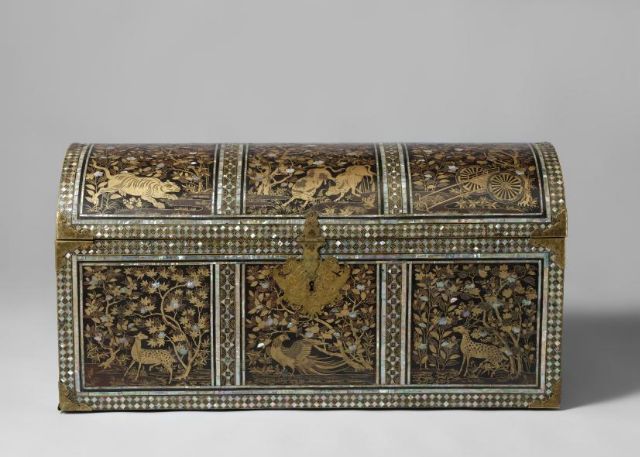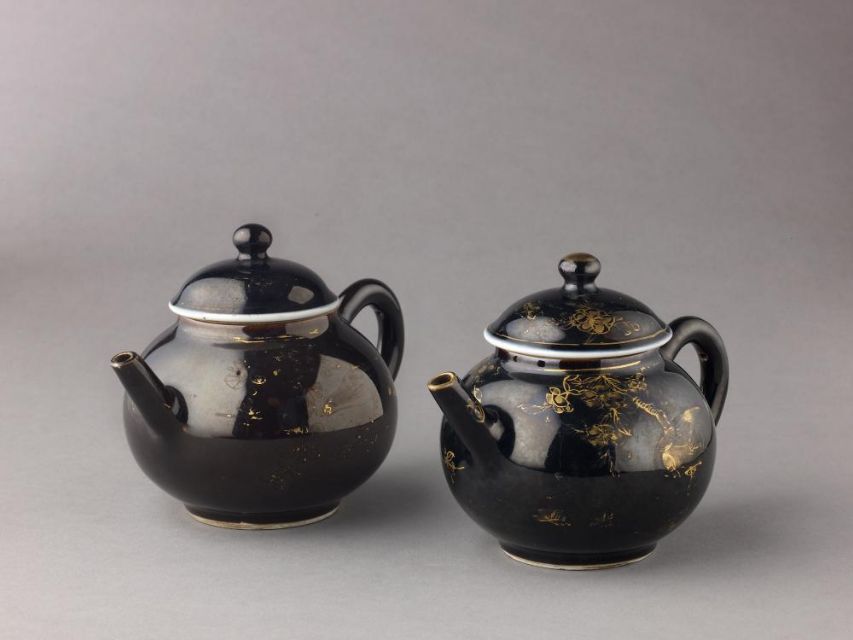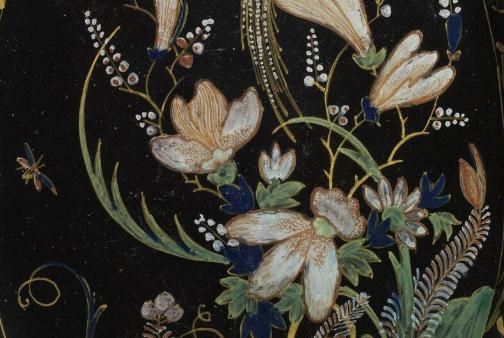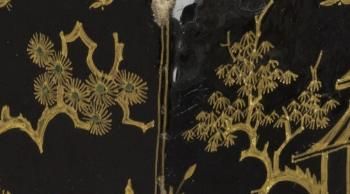Fake it till you make it
- Black Tea Canister
Before lacquerware was imitated in Europe, it was a real collector’s item in elite circles and admired for its mysterious material qualities. Consequently, Nanban lacquerware, meant for export to Europe, was produced in Japan. This practice already started around 1570. This export lacquerware was distinct from the native production, especially in forms of imagery, where the style was altered to fit the taste of the European customer. An example that demonstrates these entanglements between Asia and Europe is this marvelously decorated Nanban chest inlaid with mother of-pearl [fig.7].
Trade with China flourished throughout the 17th century, and significant numbers of goods were shipped. The large porcelain supplies created competition with the potters in Delft, who strived to discover the secrets of porcelain. Around 1650, this trade was interrupted due to a Chinese civil war. In Delft, the adaptive potters tried to fill this gap by producing wares that emulated the ones from overseas. This fabrication of imitation porcelain was referred to as Hollants Porceleyn: Dutch porcelain.
Nevertheless, it was impossible to copy the thin and high-quality Chinese porcelain because of the absence of raw materials. The required clay to produce porcelain (called kaolin) was not found in Holland. Instead, local clay and tin glaze were used. The introduced imitation porcelain was the second best thing and was considered a good alternative to the real deal. The fact that inspiration was taken from Chinese wares is visible in this canister and dish with oriental imagery [fig.8&9].
In addition to making imitation wares, the Dutch also decorated imported blank porcelain with enamels. Here, inspiration was taken from Chinese and Japanese styles, such as Kakiemon and Imari designs and accompanying palettes. The Dutch also invented imaginary motifs and scenes to represent the ‘oriental aura’. In short, they moved from directly copying to emulating styles on European shapes. The Asian and European aesthetics intertwined to cater to the demand of the market.
The quest for lacquerware followed a similar trend as porcelain. In the late 17th century, a new taste for small lacquered objects emerged.
Concurrently, a taste for black ceramics was developed and the concept of mimicking lacquerware expanded to the realm of earthenware. Delft potters tried to emulate the aesthetic of lacquerware to create Black Delftware pieces, like this richly decorated plaque with flower motifs [fig.11]
At the same time Black Delftware was being developed, objects with a similar fascination towards lacquerware entered the market in China during the Kangxi period (1622-1722). A similar type of ideology, but closer to home. Highly technical methods were utilized to attain the lacquered effect. These types of porcelain influenced Black Delftware as well, since Europeans encountered these pieces which were imported in small quantities. To a degree, variants of Black Delftware resemble these different kinds of Chinese porcelain products or clearly derive inspiration from them.
First of all, the Famille Noire porcelain resembled the appearance of Japanese lacquerware decoration.
Another type of porcelain references the Raden (螺鈿) lacquering technique in which paper thin layers of mother-of-pearl are glued on the surface. The imagery is cut and placed on the surface like a puzzle, covered in lacquer and polished until visible again. For example, the vase with mother-of-pearl inlay work [fig.13]. Vases like these are costly and extremely rare since each piece has to be cut, polished and lacquered before being applied to the black surface. When looking at the details, it immediately becomes clear why it would take forever to produce such a vase. Lastly, a porcelain innovation that resembled the plain glossy finish of lacquerware was the wujin (‘black bronze’) porcelain: the so-called Mirror Black. These porcelain wares are immersed in a thick and lustrous black glaze, as seen in the dish with gold bird and chrysanthemum decoration [fig.14]. The same applies to the very modern-looking ‘double gourd’ vase [fig.15]. The glaze is produced using cobalt with manganese and iron and fired at a high temperature to provide an iridescent look in the end product. Two different categories exist: one version is monochrome black, and the other is enriched with gold-colored gilt decoration. The version with the decoration is akin to the Maki-e (蒔絵) lacquering style, primarily black and sprinkled with gold (or silver) metal powder. The top layer of Mirror Black porcelain was sensitive to wear and tear and frequently faded away, leaving somewhat of a glare or residue where the decoration was applied originally. The latter is prominent in the left teapot [fig.16], where the details have worn off.
Traces of these styles are recalled in Black Delftware pieces, in which two categories can be distinguished. One type is Delftware, which is almost entirely black. The yellow-gold decoration resembles the glossy Mirror Black porcelain, and the other bears a resemblance to the ornamented black and white Famille Noire porcelain.
It is interesting to note that not only black, but also brown Delftware was made. This brown variant is even more uncommon. The small brown teapots [fig.19&20] with yellow-golden floral decorations illustrate this type. An olive-green fond was used to achieve this brown surface. Both are produced by the same factory: Het Jonge Moriaanshooft.

Fig. 7: Anonymous, Trunk of Nanban/Namban lacquerware, Japan, c. 1600, wood (plant material), gold lacquer (coating), mother-of-pearl, copper (metal), 47.5× 93.8 × 40.1 cm (h,w,d), Rijksmuseum, Amsterdam, AK-RAK-2009-1, Purchased with the support of the Vrienden van het Rijksmuseum, http://hdl.handle.net/10934/RM0001.COLLECT.468278

Fig. 8: De Grieksche A, Tea caddy with the arms of the Zinzendorf family, Delft, c. 1685-1695, faience, height 27.2×13×9 cm (h, l, w), Rijksmuseum, Amsterdam, inv.nr. BK-1962-54, http://hdl.handle.net/10934/RM0001.COLLECT.14309

Fig. 9: Willem Jansz. Verstraeten (attributed to), Dish with Chinese landscape, Haarlem, c. 1650- 1660, faience, 5.7 cm (h), 37.7 cm (d), Rijksmuseum, Amsterdam, inv.nr. BK-NM-8242, Gift of A. Bredius, The Hague, http://hdl.handle.net/10934/RM0001.COLLECT.14405

Fig. 10: Willem Kick (attributed to), chest of lacquered oak, Amsterdam, 1618, oak wood, varnish, 12×15.4×11.95 cm (h,w,d), Rijksmuseum, Amsterdam, AK-RAK-2009-1, http://hdl.handle.net/10934/RM0001.COLLECT.442168

Fig. 11: Factory unknown, plaque, painted with Chinoiserie floral pattern with birds, polychrome on black ground, border marbled two pierced suspension holes, Delft, 1690-1725, tin- glazed earthenware, enamels, 25.6 × 19.5 cm (h,w), Victoria and Albert Museum, inv.nr. 129-1887, https://collections.vam.ac.uk/item/O159529/plaque-unknown/

Fig. 12: Factory unknown, plaque, painted with Chinoiserie floral pattern with birds, polychrome on black ground, border marbled two pierced suspension holes, Delft, 1690-1725, tin- glazed earthenware, enamels, 25.6 × 19.5 cm (h,w), Victoria and Albert Museum, inv.nr. 129-1887, https://collections.vam.ac.uk/item/O159529/plaque-unknown/

Fig. 13: Anonymous, vase with figures in a water landscape and ornamental borders, China, c.1700- 1799, Qing-dynasty, Kangxi-period, porcelain, mother-of-pearl, lacquer (coating), 20.9 cm (h), 4.9 cm (d), 11.6 (d), 6.5 cm (d), Rijksmuseum, Amsterdam, inv.nr. AK-RBK-1977-120, V.R. van Poelgeest-Spatkowa Bequest, Amsterdam, http://hdl.handle.net/10934/RM0001.COLLECT.145233

Fig. 14: Porcelain with mirror black glaze painted with gold decoration, China, Jiangxi province, 1661-1722, Qing dynasty, Kangxi reign, 20.4 cm (d), Severance and Greta Millikin Collection , inv.nr. 1964.209, https://www.clevelandart.org/art/1964.209

Fig. 15: Anonymous, gourd-shaped vase, China, 18th century, Qing dynasty, porcelain with mirror- black glaze (Jingdezhen ware), 20.3 cm (h), ceramics, bequest of Robert West, 1950, The Metropolitan Museum of Art, New York, inv.nr. 50.221.40, https://www.metmuseum.org/art/collection/search/47050

Fig. 16: Anonymous, covered teapot or winepot (pair), Chinese, 1662–1722, Qing Dynasty, Kangxi period, Porcelain with mirror black-glazes, painted in overglaze gilt, 10.2 cm (h), ceramics, Robert Lehman Collection, 1975, The Metropolitan Museum of Art, New York, inv.nr. 1975.1.1703, https://www.metmuseum.org/art/collection/search/461263

Fig. 17: Anonymous, covered teapot or winepot (pair), Chinese, 1662–1722, Qing Dynasty, Kangxi period, Porcelain with mirror black-glazes, painted in overglaze gilt, 10.2 cm (h), ceramics, Robert Lehman Collection, 1975, The Metropolitan Museum of Art, New York, inv.nr. 1975.1.1703, https://www.metmuseum.org/art/collection/search/461263

Fig. 18: Detail of De Metaale Pot, tea canister and lid, Delft, ca. 1700-1724, Tin-glazed earthenware, painted in enamels, 10.2 × 5.7cm (h, w), Victoria and Albert museum, London, inv.nr. C.2346&A-1910, https://collections.vam.ac.uk/item/O118502/tea-canister-and-metalen-pot- factory/

Fig. 19: Het Jonge Moriaanshooft (marked ‘LVD’:Lieve van Dalen), teapot, painted with yellow flowers on a brown-green background, Delft, c. 1695-1715, earthenware, tin glaze, 10.2 × 14.4 × 9.0 cm (h,w,d), Rijksmuseum, Amsterdam, inv.nr. BK-NM-11746, http://hdl.handle.net/10934/RM0001.COLLECT.233804

Fig. 20: Het Jonge Moriaanshooft (marked LVD in yellow for Lieve van Dalen, the owner), brown- glazed spherical teapot and cover, Delft, c.1700, 8 cm (h), courtesy: Aronson Antiquairs, Amsterdam, inv.nr. D2013, https://www.aronson.com/object/d2013-brown-glazed-teapot-and- cover/